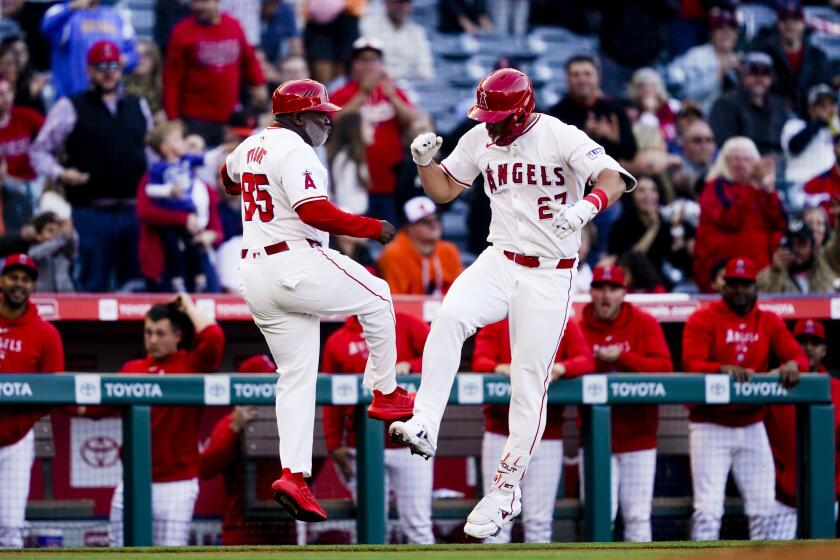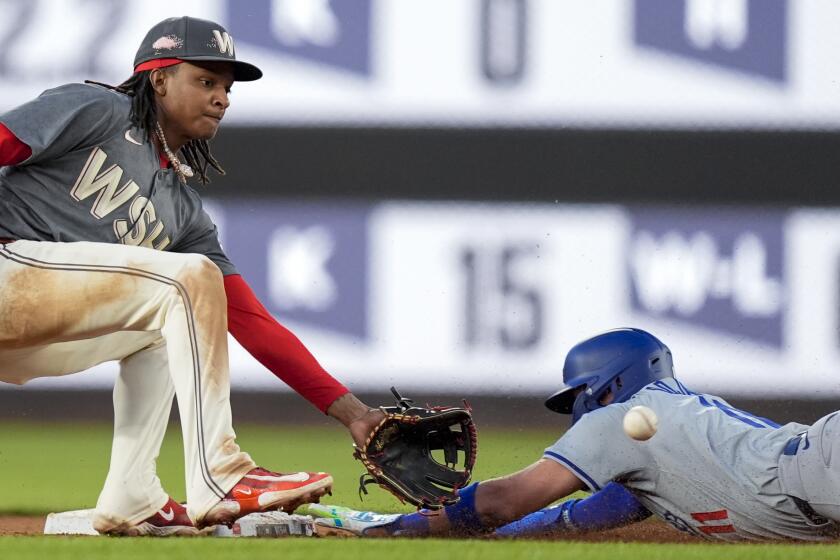Thirty years ago, Oakland A’s pitchers generally finished what they started
Slipping on an Oakland A’s jersey as a starting pitcher 30 years ago meant being dressed for the nines.
Come hell or high-water pants with socks pulled to the knees, Manager Billy Martin expected his starters to throw a complete game — pitch counts be damned.
“If you didn’t go nine innings,” said Steve McCatty, one of the A’s starters, “you didn’t feel like you did your job.”
More often than not, they got the job done.
Oakland’s pitching staff in 1980 and ’81 combined for 154 complete games in 271 starts — nearly 57%. (This season, through Sunday, there had been a total of 118 complete games in the major leagues, in 2,840 starts — 4%.)
Philadelphia’s Roy Halladay, considered baseball’s ironman pitcher these days with six complete games in 19 starts, would have been a laggard if he played for those A’s teams.
In 1980, Rick Langford finished 28 of the 33 games he started. Mike Norris completed 24 of 33, Matt Keough 20 of 32, McCatty 11 of 31 and Brian Kingman 10 of 30.
The next season, which was shortened to 109 games by a strike, the staff had 60 complete games, nearly doubling the 33 complete games compiled by the next-closest team.
Langford finished 18 of 24 games, McCatty 16 of 22, Norris, lagging well behind his pace of the previous season, 12 of 23.
Over the last 13 years, only one major league pitcher has matched even Norris’ 1981 complete-game total — Randy Johnson in 1999, and that was in a 162-game season.
The fallout from the A’s heavy workload was severe. Five promising careers ended prematurely and other teams more strictly enforced pitch limits to protect their starters.
“You’re not going to see that in today’s game, mainly because of the mind-set,” said Bert Blyleven, who will be inducted into the Hall of Fame on Sunday after a 22-season career in which he amassed 242 complete games. “They have the pitch count and so-called quality starts of six innings today.”
One reason Martin wanted his starters to pitch deep into games was that the late manager thought he had the best rotation ever assembled — Langford, McCatty, Norris, Keough and Kingman were dubbed “The Five Aces.” But mostly, Martin just wanted to minimize a suspect bullpen.
“Let’s face it, we didn’t have any Dennis Eckersleys out there,” Norris said.
So Martin would hand his starters the ball and rarely ask for it back. In 1981, the A’s won their first 11 games, with the starters going the distance nine times. Reliever Tom Underwood, traded from the New York Yankees to Oakland in May, told McCatty he soon realized he wouldn’t pitch most days he wasn’t used as a spot starter.
Pitch counts were kept but never used to determine when a starter was done. Langford, the most economical of the bunch, would average about 110 pitches in nine innings, according to McCatty, who usually threw between 130 and 140 pitches in his complete games.
Sometimes they needed a lot more pitches than that. Langford, Keough, Norris and McCatty each threw a 14-inning complete game in 1980, when the A’s set a major league record with 94 complete games. Norris needed 152 pitches to get through his extra-inning marathon.
McCatty? Two hundred and seven. When Martin came out to see how his pitcher was feeling in the 11th inning, the right-hander sent him marching back to the dugout.
Recalled McCatty: “I said, ‘I’m staying out here one way or another. I’m getting a win or a loss.’”
It was a loss, on a 14th-inning homer by Seattle’s Dan Meyer that gave the Mariners a 2-1 victory.
Martin routinely checked on his pitchers late in games even though they knew all too well he had no intention of taking them out.
“If you told him you were tired, he would look at you like you were less of a man,” Norris said. “So I told him to get the hell out of there. Of course you’re tired. But it’s a gut-check. It’s a matter of intestinal fortitude at that point.”
Peer pressure also contributed. One day after being shelled and coming out of a game after only 12/3 innings, McCatty started again and lasted 81/3 innings in a victory over Seattle.
“What, you can’t go nine?” Oakland center fielder Dwayne Murphy teased McCatty afterward.
The starters went the distance in leading the A’s to the 1981 playoffs only two years removed from a 108-loss season. Langford’s 18 complete games and McCatty’s 14 victories were both major league bests.
Oakland swept Kansas City in the AL division series but fell victim to its shoddy offense — a season-long nemesis — during the league championship series against the Yankees. The A’s batted .222 and scored a total of four runs while being swept in the best-of-five series.
And just like that, what had seemed like a budding pitching dynasty crumbled. The one-of-a-kind Martin had beat (down) five aces, all in their 20s.
Collectively, the A’s starters accounted for 37 complete games in 1982, five in ’83 and four in ‘84, their careers derailed by an assortment of shoulder and elbow injuries tied to their workload. Kingman was finished after the ’83 season, at age 29. Keough never pitched past 31. Langford was released by Oakland after starting the 1985 season 1-10. He was 34.
“I kind of took it in stride that it’s collateral damage for what we did,” said McCatty, who threw his last pitch at 31 and is now pitching coach for the Washington Nationals. “Would we all have liked to have played longer and not get hurt? Sure. Can I say I would trade it? I can’t say that. We wanted to play. If it ended up costing us our careers, so be it.”
Norris had surgery after the 1983 season to repair nerve blockage in his shoulder and didn’t throw another pitch in the major leagues until a brief comeback with the A’s seven years later.
“I was pretty much half the pitcher I was before,” said Norris, whose career also stalled because of drug problems.
Now 56, Norris is partially paralyzed below the waist as the result of a spinal cord defect he feels may be related to his overuse. His 13-year-old daughter has never seen him walk without the assistance of crutches.
“It was no one’s fault,” Norris said of his injuries. “You can’t blame that on Billy. That’s what we did. If I had to do it all over again, I would do it the same way.”
Starters generally have been handled with greater care over the last 30 years, particularly with the expansion of bullpens and use of pitch limits to protect starters. Early in his career, Angels ace Jered Weaver said, he was rarely allowed to exceed 100 pitches in a start.
“Now I’m getting a little more leeway to throw the 120, 125 pitches and I’ve been able to get a couple of more complete games,” said Weaver, who has four (in 20 starts), already tying a career high.
Angels Manager Mike Scioscia said pitch counts can be a tool to shield starters from injury but are not infallible.
“There’s certainly a priority on protecting a pitcher’s health and his stuff and his career,” Scioscia said, “but sometimes limiting their work is not the best way to do it because a lot of guys have pitched a long time by really being workhorses who kept their arm where it needed to be.”
In 1981, the A’s starters could usually count on being on the mound when the game ended. Norris still marvels at the results.
“It’s quite an accomplishment,” he said, “because in this day and age it will never be accomplished again.”
More to Read
Get our high school sports newsletter
Prep Rally is devoted to the SoCal high school sports experience, bringing you scores, stories and a behind-the-scenes look at what makes prep sports so popular.
You may occasionally receive promotional content from the Los Angeles Times.







